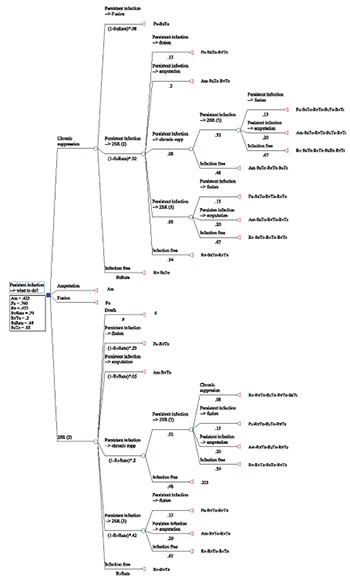Knee Arthrodesis is Most Likely to Control Infection and Preserve Function Following Failed 2 Stage Procedure for Treatment of Infected TKA: A Decision Tree Analysis.
Authors: Gray CF, Wu C, Baldwin KB, Lee GC. University of Pennsylvania Health System, Philadelphia, PA
Title: Knee Arthrodesis is Most Likely to Control Infection and Preserve Function Following Failed 2 Stage Procedure for Treatment of Infected TKA: A Decision Tree Analysis.
Background: Infection following total knee arthroplasty (TKA) is a catastrophic complication. In the United States, for chronic, first time infected TKA, the gold standard remains a 2-stage reimplantation (2SR) procedure with reported success rates approaching 90%. However, there is a lack of consensus on the treatment of subsequent reinfections.
Hypothesis/Purpose: The purpose of this study was to use published data on infected TKA to develop a decision tree analysis to determine the treatment method likely to yield the highest quality of life for a patient following a failed 2SR.
Methods: We performed a systematic review of the English literature to determine the expected success rates and functional outcomes of a 2SR procedure, chronic suppression, arthrodesis, and amputation for treatment of infected TKA. Utility and disutility tolls were derived for each treatment option and a decision tree analysis was conducted using TreeAgePro 2012 (Williamstown, Massachusetts). The efficacy of each of the treatment nodes was calculated based on prior published methods for each study. These values were subsequently varied to perform a sensitivity analysis.
Results: Initial search yielded 204 papers; 18 studies met inclusion criteria. The composite success rate for 2SR was 79.1% (range 33.3%-100%). The utility and disutility toll (cost for treatment) for 2SR were 0.473 and 0.20, respectively; the toll for undergoing chronic suppression was set at 0.05; the utility for arthrodesis was 0.740 and for amputation 0.423. In all iterations of the decision tree analysis with varying sensitivities, knee arthrodesis emerged as the treatment most likely to yield the highest expected quality of life following a failed 2SR for infection.
Discussion: Our study found that 2SR is successful at a lower rate than that traditionally cited. We also describe, for the first time, the typical rate at which salvage procedures are utilized after a failed 2SR. Finally, our study suggests that a successful fusion optimizes the patient’s expected quality of life after a first failed 2SR. This outcome held up through sensitivity analysis.
Conclusion: Based on best available evidence, knee arthrodesis should be strongly considered as the treatment of choice for patients who have persistent infected TKA following a failed 2-stage reimplantation procedure.

